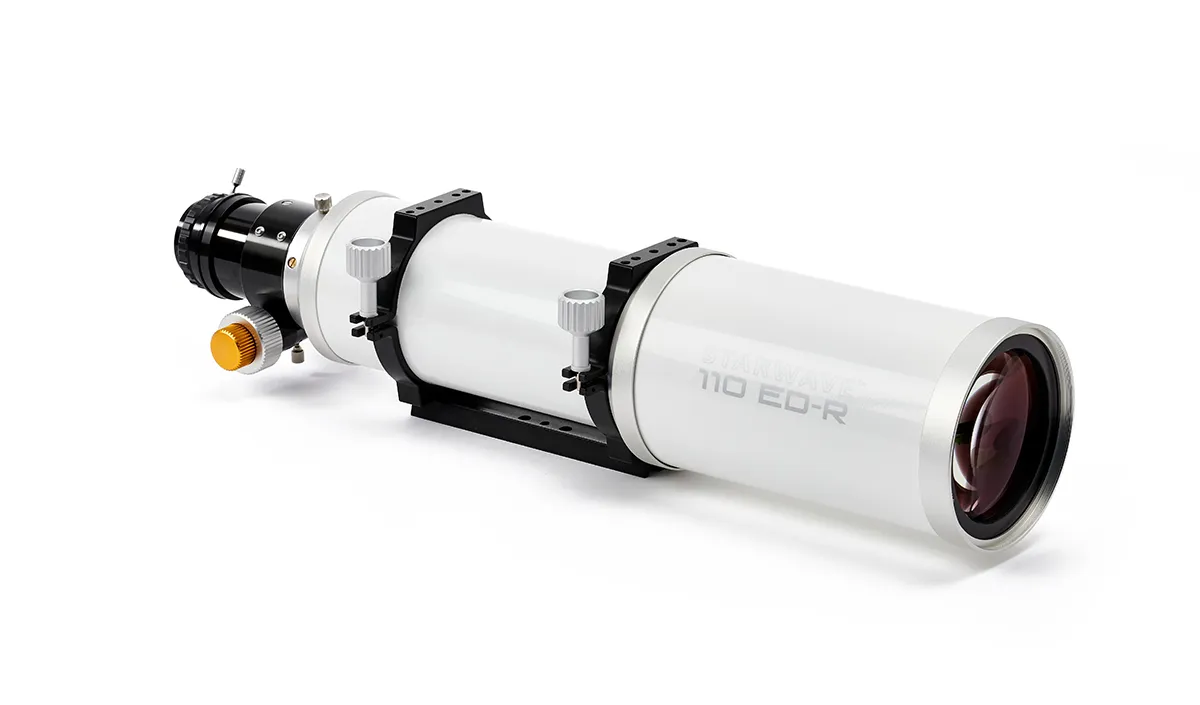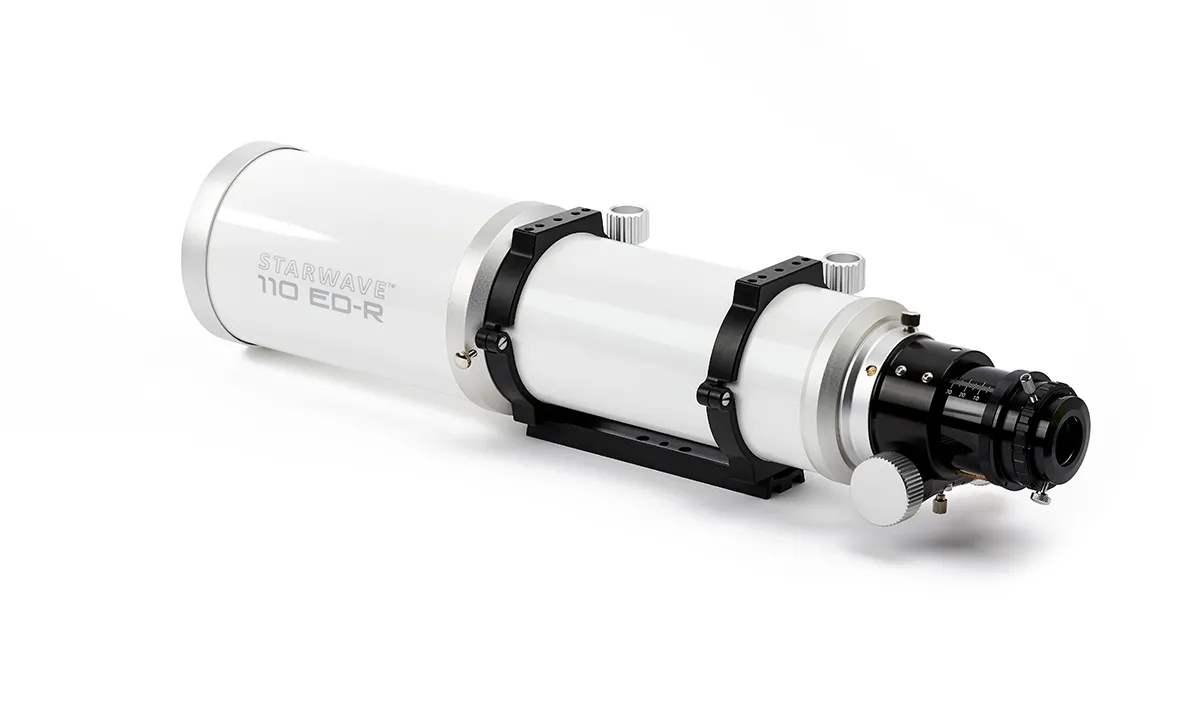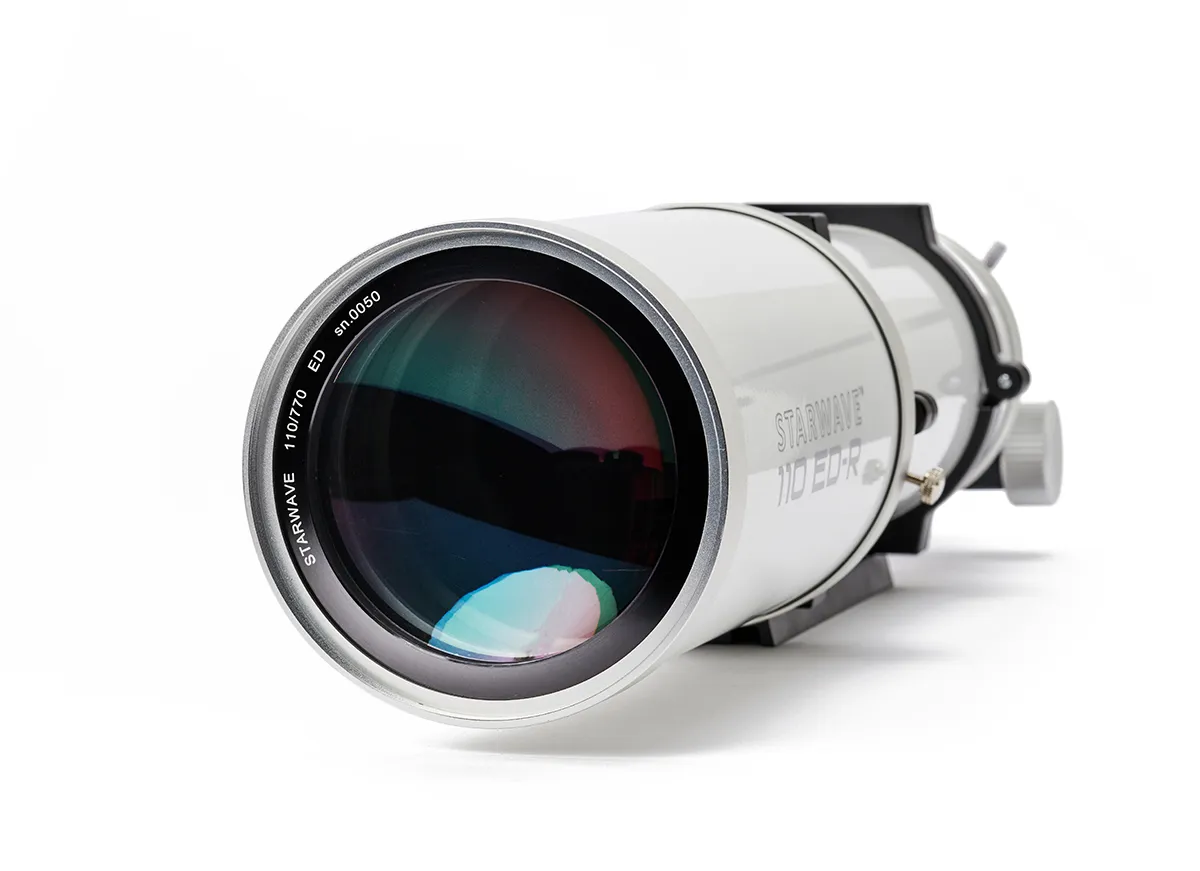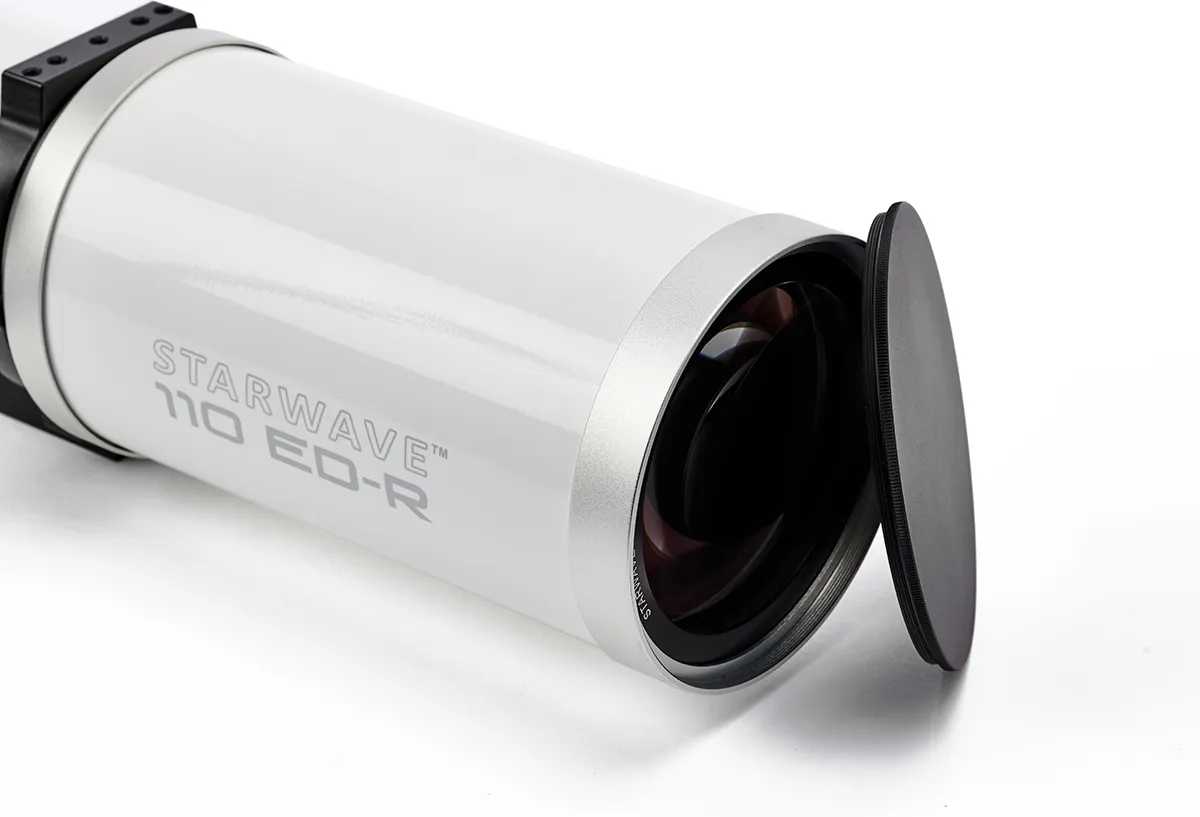The Altair Starwave 110ED-R refractor is a welcome update to Altair’s established product range, the ‘R’ indicating an upgraded rack and pinion focuser with additional features for an improved experience.
Indeed, the improved construction and finish stays true to the reputation of Starwave’s telescopes, with smoothly machined fittings and flat silver trimmings, complemented by a luxurious, metallic white paint job.
The solid look and feel of the tube assembly has been achieved with the reduction of excessive weight in mind; we were pleasantly surprised about how manageable the telescope was to lift from its aluminium padded case (for more scopes like this, read our list of the best travel telescopes).

It was also reassuring to discover – after lugging weighty refractors around over the years – that the 6.8kg Starwave 110ED-R represents an ideal compromise between aperture and portability, offering a large enough 110mm doublet lens for viewing at an enjoyable resolution, while being easy to transport in its protective case.
We found that the balance and length of the Starwave made it an easy fit when it was attached to our EQ mount – sitting neatly in a central position – as the lens cell and focuser are just 60cm apart.This in turn translates into a more comfortable viewing experience for observing objects at a range of altitudes.
The upgraded focuser – with its rack and pinion design – makes focusing smooth and precise, while the 1:10 gearing allows easy fine-focusing when the system is used at high magnification.
The whole assembly is rotatable, and rather than thumbscrews to hold your eyepiece or camera, a simple twist ‘Positive Lock’ system is employed. Indeed, once it was tightened and locked in place, we didn’t have to worry that this might work loose and release its valuable payload.

For our first viewing session we concentrated on a bright waxing Moon – using our Tele Vue Delos 4.5mm eyepiece – and worked with a magnification of 170x to scan the craters and features near the terminator.
It proved to be a rewarding experience, with sharp lunar details along the crater edges and sides. Shadows cast by taller craters and central peaks were crisp and clean, while clearly defined edges within and behind the crater walls indicated the jagged nature of the rims, which are not always as obvious.
Enjoying this spell of good seeing we turned the view to the 101km-wide crater Plato and were pleased to catch glimpses of the four craterlets within.
With a doublet telescope like the Starwave, sometimes called a ‘semi-apo’, we were expecting to see some colour fringing, especially on a bright object like the Moon.
Indeed, there was an indigo fringe around its bright limb, which was especially noticeable with the 4.5mm eyepiece, but considerably less so with our 10mm and almost inconsequential to the view.

Unfortunately, Jupiter and Saturn were not ideally positioned during the review period, but we still managed to see some nice colour banding on both planets and (considering the elevation) good variation within Saturn’s rings.
Mars on the other hand presented an altogether more satisfying spectacle and the bright, multicoated optics of the Starwave presented a remarkable view of the Red Planet at a magnification of 170x, with its distinct polar regions and darker albedo regions clearly visible.
Altair has a dedicated reducer-flattener lens that can be used for astrophotography with the Starwave 110ED-R, but we opted to use the telescope at its normal focal length with both monochrome and colour cameras for comparison.
The colour images we obtained, such as of the Dumbbell Nebula, M27, showed a good transmission of colour – including those of hydrogen emission – with some expected blue fringes around brighter stars and a little coma.
Although our imaging time was limited by adverse weather, the Starwave demonstrated its potential appeal to more discerning imagers when we used it with a monochrome camera and narrowband or colour filters.
Our image of the Pacman Nebula, NGC 281, revealed features with good definition and contrast, and a favourable imaging scale.
Overall, we found the Starwave 100ED-R was most enjoyable to use, offering a healthy balance between aperture and portability.

In praise of the objective lens
The objective lens of the Starwave is a 110mm, f/7 doublet, with a fluorophosphate, low-index glass element, known as FPL-51 ED.
This lens arrangement allows reasonable control of the various colours (or wavelengths) of visible light, bringing them to focus together for a sharper, more pleasing eyepiece view and reducing chromatic aberration when compared to an achromatic lens.
Altair Astro informs us that each scope is guaranteed to arrive with properly collimated, or aligned, lenses. The lens cell comes with a matching star test image produced from a double-pass autocollimator.
We tested this for ourselves – as the finely tuned collimation of a refractor is essential for viewing close double stars and sharper planet features – and were reassured to see several craterlets within the lunar crater Plato.
Doublet refractors require less cool-down time than an equivalent sized triplet telescope, and FPL-51 ED (Extra low dispersion) glass is one of the more thermally stable options, again helping to improve the eyepiece view.

Altair Starwave 110ED-R's best features
Positive Lock system
The Positive Lock system replaces standard thumbscrews, and tightly clamps 2-inch nosepiece fittings without damaging them. To use it, simply rotate the knurled ring 45° anti-clockwise, insert the nosepiece of your eyepiece or camera, then rotate the ring clockwise to lock it. This attachment unscrews to allow direct fitting of the separately available reducer-flattener lens.
Rack and pinion 2.5-inch focuser
The preferred design choice of many astrophotographers, the smooth rack and pinion focuser extends to a full 95mm, with graduated measurements on the baffled drawtube. Loosening the thumbscrew in the silver ring allows the whole assembly to rotate, making it easy to frame photographs, or to position the focuser for maximum convenience while observing.
CNC tube rings
The Starwave is supplied with lightweight, CNC-machined tube rings and a Vixen-style dovetail plate, all with a good quality finish. There are five M6 threaded holes at the top and bottom of the rings, allowing the secure fitting of accessories, while the flat silver turnscrews match the telescope’s finish.
Extending dew shield and screw-on end cap
The well-constructed dew shield extends a full 185mm without sagging, providing protection from stray light and helping to keep moisture from the elements at bay. The dust cap screws firmly into the end of the dew shield, and cannot fall off, further emphasising the build quality of the Starwave.
Aluminium storage case
A sturdy, well-padded and lockable aluminium storage case is provided with the telescope, making it easy to safely transport and store. Measuring just 775mm x 245mm x 230mm, it is easy to handle and in total – with the Starwave stowed safely inside – weighs just 9.6kg.
Vital stats
- Price £925
- Optics Doublet lens with FPL-51 ED element
- Aperture 110mm
- Focal length 770mm (f/7)
- Focuser 2.5-inch rack and pinion with Positive Lock adaptor
- Extras Tube rings, Vixen-style dovetail plate and a carry case
- Weight 6.8kg
- Supplier Altair Astro
- Tel 01263 731505
- www.altairastro.com
This review originally appeared in the November 2020 issue of BBC Sky at Night Magazine.
